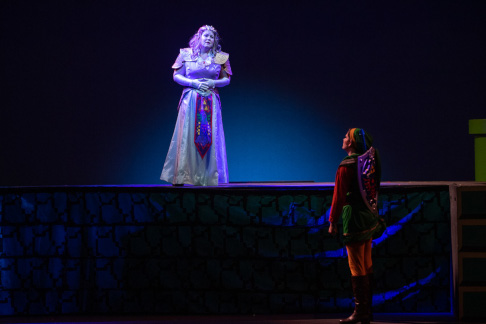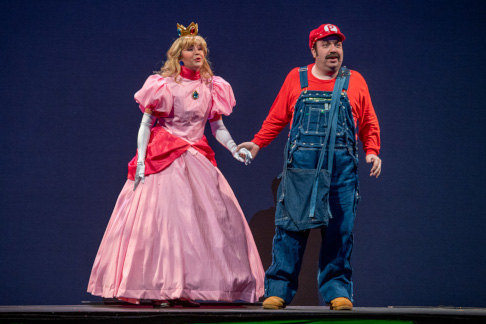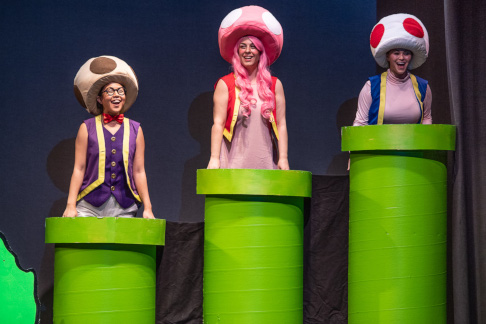![Scene from The Magic Flute [Photo by Martha Benedict]](http://www.operatoday.com/flute-1112.jpg)
06 Mar 2019
Super #Superflute in North Hollywood
Pacific Opera Project’s rollicking new take on The Magic Flute is as much endearing fun as a box full of puppies.
English Touring Opera are delighted to announce a season of lyric monodramas to tour nationally from October to December. The season features music for solo singer and piano by Argento, Britten, Tippett and Shostakovich with a bold and inventive approach to making opera during social distancing.
This tenth of ten Live from London concerts was in fact a recorded live performance from California. It was no less enjoyable for that, and it was also uplifting to learn that this wasn’t in fact the ‘last’ LfL event that we will be able to enjoy, courtesy of VOCES8 and their fellow vocal ensembles (more below …).
Ever since Wigmore Hall announced their superb series of autumn concerts, all streamed live and available free of charge, I’d been looking forward to this song recital by Ian Bostridge and Imogen Cooper.
Although Stile Antico’s programme article for their Live from London recital introduced their selection from the many treasures of the English Renaissance in the context of the theological debates and upheavals of the Tudor and Elizabethan years, their performance was more evocative of private chamber music than of public liturgy.
Evidently, face masks don’t stifle appreciative “Bravo!”s. And, reducing audience numbers doesn’t lower the volume of such acclamations. For, the audience at Wigmore Hall gave soprano Elizabeth Llewellyn and pianist Simon Lepper a greatly deserved warm reception and hearty response following this lunchtime recital of late-Romantic song.
For this week’s Live from London vocal recital we moved from the home of VOCES8, St Anne and St Agnes in the City of London, to Kings Place, where The Sixteen - who have been associate artists at the venue for some time - presented a programme of music and words bound together by the theme of ‘reflection’.
'Such is your divine Disposation that both you excellently understand, and royally entertaine the Exercise of Musicke.’
‘And there was war in heaven: Michael and his angels fought against the dragon; and the dragon fought and his angels, And prevailed not; neither was their place found any more in heaven … that old serpent … Satan, which deceiveth the whole world: he was cast out into the earth, and his angels were cast out with him.’
There was never any doubt that the fifth of the twelve Met Stars Live in Concert broadcasts was going to be a palpably intense and vivid event, as well as a musically stunning and theatrically enervating experience.
‘Love’ was the theme for this Live from London performance by Apollo5. Given the complexity and diversity of that human emotion, and Apollo5’s reputation for versatility and diverse repertoire, ranging from Renaissance choral music to jazz, from contemporary classical works to popular song, it was no surprise that their programme spanned 500 years and several musical styles.
The Academy of St Martin in the Fields have titled their autumn series of eight concerts - which are taking place at 5pm and 7.30pm on two Saturdays each month at their home venue in Trafalgar Square, and being filmed for streaming the following Thursday - ‘re:connect’.
The London Symphony Orchestra opened their Autumn 2020 season with a homage to Oliver Knussen, who died at the age of 66 in July 2018. The programme traced a national musical lineage through the twentieth century, from Britten to Knussen, on to Mark-Anthony Turnage, and entwining the LSO and Rattle too.
With the Live from London digital vocal festival entering the second half of the series, the festival’s host, VOCES8, returned to their home at St Annes and St Agnes in the City of London to present a sequence of ‘Choral Dances’ - vocal music inspired by dance, embracing diverse genres from the Renaissance madrigal to swing jazz.
Just a few unison string wriggles from the opening of Mozart’s overture to Le nozze di Figaro are enough to make any opera-lover perch on the edge of their seat, in excited anticipation of the drama in music to come, so there could be no other curtain-raiser for this Gala Concert at the Royal Opera House, the latest instalment from ‘their House’ to ‘our houses’.
"Before the ending of the day, creator of all things, we pray that, with your accustomed mercy, you may watch over us."
The doors at The Metropolitan Opera will not open to live audiences until 2021 at the earliest, and the likelihood of normal operatic life resuming in cities around the world looks but a distant dream at present. But, while we may not be invited from our homes into the opera house for some time yet, with its free daily screenings of past productions and its pay-per-view Met Stars Live in Concert series, the Met continues to bring opera into our homes.
Music-making at this year’s Grange Festival Opera may have fallen silent in June and July, but the country house and extensive grounds of The Grange provided an ideal setting for a weekend of twelve specially conceived ‘promenade’ performances encompassing music and dance.
There’s a “slide of harmony” and “all the bones leave your body at that moment and you collapse to the floor, it’s so extraordinary.”
“Music for a while, shall all your cares beguile.”
The hum of bees rising from myriad scented blooms; gentle strains of birdsong; the cheerful chatter of picnickers beside a still lake; decorous thwacks of leather on willow; song and music floating through the warm evening air.
![Scene from The Magic Flute [Photo by Martha Benedict]](http://www.operatoday.com/flute-1112.jpg)
Pacific Opera Project’s rollicking new take on The Magic Flute is as much endearing fun as a box full of puppies.
And as ingenious Executive and Artistic Director Josh Shaw has reimagined the piece (marketed as #Superflute), the staging is also just about as relentlessly and adorably rambunctious, all the while proving to be commendably musically refined.
In tandem with E. Scott Levin (also the evening’s Papageno), the duo have created libretto and lyrics that set this evergreen Mozartian musical fantasy in the milieu of 1990’s video games and have peopled its cast with a fascinating interaction of disparate heroes, royalty, and nemeses plucked from varied sources.
Truth up front: this writer never played any of those games, and aside from a couple of personages that became pretty unavoidable pop icons, I wasn’t much aware of the sources. Will it surprise you to know that it didn’t matter? Not a bit. To their immense credit, Mssrs. Levin and Shaw have honored the original character relationships with amazing fidelity, and they have actually enhanced the clarity of what is after all a Singspiel whose storylines, style, unities, symbolism, subtext, and parallel plots are all over the map.

Indeed, a pantomime during the overture set it all up, as couch potato gaming geeks fought over which program they would upload and participate in. As a long-suffering parent “pulls” the plug on the equipment, the projections take on a “magic” life of their own and further clarify the characters by listing the players with their video game alter egos. Holy Wolfgang, that’s pretty clever stuff. Those of us “in the dark” were enlightened, while those “in the know” were spun into a minor frenzy of recognition and camaraderie.
All this would mean little were it not for the high standard of the singing and playing, and here POP really excelled. The afore-mentioned E. Scott Levin was a wholly winning Papageno (Mario Brothers Plumber). His clichéd Italian accent, charismatic engagement with the audience, and larger than life, obfuscating underdog demeanor endeared him to one and all. If Mr. Levin’s incisive baritone sometimes threatened to verge on a hectoring delivery, and if his intonation veered a bit in the duet with Pamina, his was nonetheless an assured, appealing traversal of a role that can and does walk away with the show.
Pride of place for radiant singing has to go to the assured, ringing Tamino (Link) from Arnold Livingston Geis. His polished performance was quite simply as good as it gets. Mr. Geis has a sizable lyric instrument that lavishes honeyed tone on all registers and at all volumes. His secure technique and stylish phrasing enrich the production immensely, and moreover, Arnold is handsome, winsome, and every other sort of “some.” And wittily funny to boot. It will be a pleasure to watch his star rise as it surely will.

Alexandra Schoeny deployed an uncommonly alluring, bronzed soprano as Pamina (Princess Peach), and she brought admirable dramatic spunk and sentiment to the mix. Her gleaming sound above the staff was complemented by a rich middle register, with her well-schooled tone evenly knit throughout the range.
In the notoriously difficult role of the Queen of the Night, Michelle Drever was quite an assured exponent. She dispatched both of her arias with aplomb, imbuing the slow sections with well calculated pathos, and the rapid-fire coloratura with crackling ferocity. If the lowest parts of the role lacked the same presence as the ringing top, well, no one comes to hear the Queen’s low “f”, do they?
Andrew Potter’s Sarastro was everything one could wish, his darkly sonorous, rolling bass the exact fit for his imposing music. The fact that his physical presence towers above the rest of the cast, and that he manages to somehow find the role’s dignity even in a Donkey Kong ape suit, is a testament to his mature, persuasive interpretive gifts. He also embraces the script’s humor with good-natured gusto.
Robert Norman was a wiry, characterful Monastotos (Mario Brothers Luigi), his secure, nimble tenor emanated from a fleet-footed, loose-limbed physicality that was benignly menacing. Laura Broscow proved a wholly enchanting Papagena, first as a frisky old woman high on a Geritol overdose, then as a perky princess with gold in her heart and silver in her voice. She mined every bit of humor in her duet, all the while singing it with accuracy, verve, and lilting tone.
The Three Ladies were very well-matched. Soprano Tara Whecker led the trio commandingly as First Lady; Ariel Pisturino’s plush mezzo served the Second Lady well; and Third Lady Megan Potter grounded the ensemble with her plummy alto phrases. The Spirits, often cast with boys, were on this occasion very well performed by a second trio of talented ladies. The lighter voice qualities of the assured vocalists Emily Rosenberg, Amanda Bernjamin, and Christine Maris Li entwined to beautiful effect and proved a highly effective aural balance to the weightier tones of the Ladies.

As the two Priests and the Armored Men, Jonathan Mathews and Joshua Alarcon dispatched their brief but important moments with accomplished vocalizing. Mr. Matthews sported a solid tenor that soared in the arching Priest duet, then proved to have the correct stentorian leanings in the chorale. Mr. Alarcon’s pleasing, slightly grainy baritone fell easily on the ear, and he ably complemented his partner, providing a solid foundation for the ensuing trio and quartet.
Edward Benyas indeed worked some “magic” in the pit with his assured baton eliciting stylish results from a sizable orchestra. The accomplished playing was all the more laudable since the band seemed to include a number of very young players. I have heard many an established house orchestra struggle with this varied score. It is to Maestro Benyas’ great credit that the musical execution was of a very high order throughout.
Mr. Shaw’s colorful, cheeky set design constantly strives for variety and visual interest. However, perhaps it is busier than it needs to be. Cumbersome staircases get moved fairly often simply to create a new look, different levels, or a structural element that sometimes seemed superfluous. Even though the moves were accomplished with precision and haste, they still slowed down the action and prompted the addition of orchestral music (from The Impresario) to fill the silence. And the continually changing painted cloths, fronting the wall-to-wall elevated central platform were too frequently peeled away to the riiiiiiiiiiiiiiiiiiiiiip of Velcro.
However, it has to be said there were a surprising number of special effects that tickled the eye: the revelation of cartoonish “rolling waves” under the platform, the three green stovepipe like structures that allowed characters to appear from behind and mount them, and the obstacles that appeared in the trials that had Tamino and Pamina comically hopping over them a la a video game skill challenge. In fact, the presentation of the trials was arguably the most effective I have ever seen, especially as they were presented as prerequisite to get to the next “level” of video play.
Maggie Green’s costumes ably captured the look of each iconic character’s attire and provided a riot of color and imagination. For future outings of this edition, a couple of the women’s dresses might be adjusted in certain details to better flatter the actual singers’ physical attributes rather than just recreating the original cartoon costume. However, that does not diminish Ms. Green’s over the top accomplishment in devising a wackily diverse assemblage of eye-popping dress and wigs.
Bo Tindell illuminated the proceedings with a good eye for color washes, effective area isolation, and well-judged specials. The design also managed to keep the video show backdrop and overall lighting in good balance the entire evening.
The ubiquitous Josh Shaw has directed the enterprise with a knowing sense of pace, well choreographed set changes, overall commendable traffic management, effective use of the playing space, and inspired comic business. I will not soon forget the invasion of a profusion of inflatable bananas in a Sarastro (Donkey Kong) dominated scene, with the entire animated cast brandishing them, batting them around, and cavorting about in inspired lunacy.
I would encourage the director to consider adding a movement specialist to the team. Stage pictures sometimes got repetitious or cramped, dance steps were unnecessarily limited by sameness, and character relationships might have been more meaningfully developed with better spatial interplay. And I do wish that some self-conscious jokey dishing of operatic conventions could be redirected into the character-based humor of the vast bulk of the piece.
If any purists were left standing in the face of this indisputable audience pleaser, they might wish for some cut material, like the Speaker-Tamino exchange to be reinstated. But these are minor quibbles in what was for me, a minor triumph of reimagining and retelling a jumble of a masterpiece, thereby making it more comprehensible and enjoyable to a contemporary audience.
I loved it. I think Mozart would have loved it. If not, to hell with him! POP’s The Magic Flute lives up to its #Superflute marketing handle in most every aspect imaginable.
James Sohre
The Magic Flute
Tamino: Arnold Livingston Geis; Pamina: Alexandra Schoeny; Papageno: E. Scott Levin; Queen of the Night: Michelle Drever; Sarastro: Andrew Potter; Monostatos: Robert Norman; Papagena: Laura Broscow; First Lady: Tara Whecker; Second Lady: Ariel Pisturino; Third Lady: Megan Potter; Priest/Armored Man: Jonathan Matthews, Joshua Alarcon; First Spirit: Emily Rosenburg; Second Spirit: Amanda Benjamin; Third Spirit: Christine Marie Li; Conductor: Edward Benyas; Director and Set Design: Josh Shaw; Costume Design: Maggie Green; Lighting Design: Bo Tindell